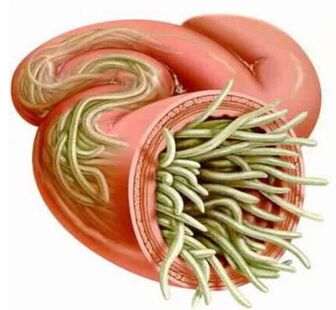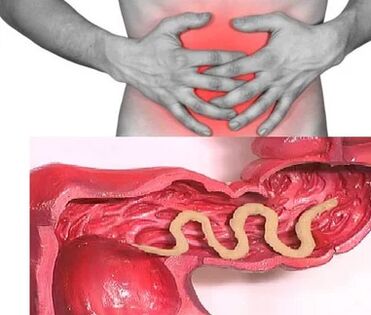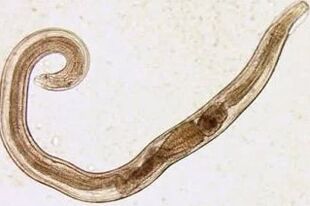To date, science is known to 280 types of verse that can develop and live in the human body, parasitizing in various organs and tissues.The frequency of human infections depends on the climatic and socio-economic conditions of specific territories (in underdeveloped countries, in particular in those located in the tropical and subtropical zone, the level of parasitic infections is much higher than in economically developed states).
Human infection methods by helminths:
- Biogelmintosis (animal infection).
- Contagioine Helmithoses (transmitted from one person to another).
- Geogelmintoses (diseases caused by parasites leading to one of the vital cycles of the earth).

Factors affecting the demonstrations of helminthias
The method of penetration of the parasite into the body:
- The degree of adaptation of helminthe to the human body;
- The density of the population (quantity) of parasitic individuals;
- Ver habitat (tissue parasites live in the thickness of the soft tissues and the clearing live in the gaps of the hollow organs).Some helminthes in different phases have educational and fabric forms.The larval stages and in the development of the worms, as a rule, cause more pronounced pathological changes.
In the absence of re-infection, the number of adult parasites in the human body does not increase.This characteristic considerably distinguishes Helminthic invasions from diseases caused by bacteria, viruses, fungi and simple organisms.
Towards in humans: symptoms
Helimosis is a disease characterized by 2 stages of the course (acute, from two weeks to two months) and chronic (from several months to several years).
Symptoms of the acute phase of Helminthiasis
The first signs of the disease can appear at different times (most often after 2 to 3 weeks, with ascaridosis-after 2 to 3 days, and with phylairiosis, the incubation period can last 6 to 18 months).
At the acute stage of the parasitic invasion, the most characteristic symptom is an allergic reaction (antibodies are generated at the antigens of migratory parasites).Often, itching, rastered rashes, subjects during recurrent course, have an increase in recurring course, regional lymph nodes appear on the skin and the occurrence of generalized or local edema, muscle and joint pain may occur.In addition, the migration of parasitic larvae can cause pain in the chest, a cough, suffocation of suffocation, stool disorders, nausea and vomiting.
At the same time, the acute phase of helminthiasis can be accompanied by more serious disorders (severe forms of pneumonia, hepatitis, allergic myocarditis, hepatosterogal (an increase in liver and spleen).
In the blood, the quantity of eosinophilia (eosinophilia) increases and the normal quantitative ratio between protein fractions (dysproteinemia) is disturbed.

Chronic Helminthiasis signs
The symptoms of the chronic phase depend directly on the “populated” organ with parasites, as well as their size and quantity play an important role.
Thus, when it is parasitic in the intestines of single individuals, the disease can occur asymptomatic (with the exception of cases of infection by very large parasites).The characteristics of the chronic phase of intestinal hellminthiasis are dyspeptic disorders.In children, acenoarotic and painful syndrome is more pronounced.With a massive invasion, ascarids, intestinal obstruction, mechanical jaundice and pancreatitis are possible.
By consuming all the substances necessary for their vital activity of the host's body, the helminths cause digestive disorders, violations of the absorption of vitamins, minerals, carbohydrates, proteins and fats.At the same time, the products of the lifespan of worms inhibit the normal intestinal microflora and reduce the immune forces of the body.
In people with Helminthias, due to weakened immunity and the improved process of cell division (consequences of constant restoration of tissue parasites), the risk of malignant tumors increases significantly.
Types of parasitic helminthes in the human body
Causal agents of human helminthiasis are 2 types of worms: round (nematodes) and flat (ribbon and saucers).
Roundwall
Lock
The parasites which are the cause of enterobiosis are small thin cavity worms (up to 10 mm) which have a grayish white coloring.The infection occurs food (through the mouth).The reason is dirty hands.Parasite eggs can be in the ground, on the wool of infected animals, vegetables and unwanted fruits, etc.At the same time, with Enterbiose, self-extent funds (especially in children) which occur following comb combs and subsequent swallows of eggs are not rare.The cutting larva is developing within two weeks in the digestive tract.Transforming into an adult individual, the parasitic worm in the lower parts of the small and upper colon.

Askarida
Askaride is a large parasite of a red-colored spindle shape, reaching an adult 40 cm (females) and 15-25 cm (males).Without a taster or other fixing devices, the ascaride can move independently to the food masses.The eggs deposited by the female parasite are distinguished with excrement.
Acaderosis infection occurs in case of mature egg tasting with water or unwashed vegetables and fruits on which there are soil particles.After the eggs penetrated the intestines, the ripe larvae come out of it.Then, introducing into the intestinal wall, they reach the heart according to the blood circulation, and from there, they fall into the lungs.Through the pulmonary cells, the Asscarida larva through the respiratory tract enters the oral cavity again.After swallowing repeated, the parasite reaches the small intestine, where it turns into an adult.The worm lives for 12 months, then dies and stands out with excrement.In the intestines of an owner, an owner can live one or more hundred people.
Vlashev
Vlasov, the causal agent of trichocephalosis, is a white helminthe which is parasitized in the initial part of the large intestine and reaches a size of 4-5 cm.The parasite is powered by the blood and the tissues of the rectal mucosa.
The eggs at the head of sobs lying by the female on the walls of the intestine come out with the excrement.Their development occurs in the environment (optimally in the soil).Eggs with parasitic larvae are penetrated into the body in a food, through dirty hands, with water or non -washed vegetables and fruits.

Trichinella
The causal agent of trichinellosis is a small round helminthe which reaches 2 to 5 mm in length.The infection occurs when the use of bad fried meat (pork, cubs bear, wild boar).Entering the intestines, the parasitic larva in 3 to 4 days matures to the state of the sexually mature individual.The life expectancy of the worm is 40 days, after which the parasite dies.By driving the intestinal wall, the larvae enter the blood circulation and are transported in all the organs of the human body, settling in the muscles.In this case, the respiratory and facial muscles, as well as the members' ado muscles, are most often affected.
In the first days following the invasion, patients complain of abdominal pain.Then, after about 2 weeks, the body temperature increases to 39-40 s, the itching appear on the skin, the muscle pain develops and the face swells.During this period, in the case of a massive infection, there is a significant risk of death.After about a month, recovery occurs.The parasite is encapsulated in a spiral form, after which he died in two years.
Ankylostoma and not -Core
These two parasites are similar to each other by biological characteristics, as well as in caused diseases.With this, it is usual to unite them under the general name (ankylostoma).The verses reaching the lengths of 10 to 15 mm are parasitized in 12-P.intestine.It should be noted that this is one of the most common parasites, but at the same time, rarely identified.Worms of worms penetrate the human body through the skin when they are in contact with infected soil.In addition, entering the blood circulation, they, like the ascarids, migrate to the lungs, then, through the bronchi, as well as the expectorations to jump - towards the digestive tract.The anquilostom is parasitic in the intestines, attaching to the intestinal wall.A parasite that eats exclusively with blood bites blood vessels piercing the mucous membrane, injecting an anti-adapted component.During the day, an adult can absorb 0.05-0.35 ml of blood on average.Consequently, the most characteristic symptom of this helminthiasis is iron iron anemia, as well as a change in the ratio of protein fractions (dysproteinemia).
Flat verse
Wide strip
It is one of the largest helminths reaching a length of 10 to 20 meters.The disease caused by this parasite is called dipillobotriosis.The development cycle of worms begins with freshwater fish or crustaceans.The larva enters the human body, which is the last owner of a large ribbon with caviar or infected fish net.Reaching the small intestine, the parasite is attached to its wall and for 20-25 days reached a sexually mature individual.
Hepatic bacon
A parasite causing the opisthorchiasis is a flat worm reaching a length of 7 to 20 mm.It should be noted that more than 50% of cases of infection by a liver saucer (it is also called Biconomater cat) belongs to the inhabitants of Russia.The parasitic larvae begin to develop after the eggs fall into fresh water (swallowed snails).Then they enter the body of the fish (carp, carp crucian, bream, roach).Human infection occurs when you eat infected fish meat that has not suffered sufficient heat treatment.The hepatic bomb larva of the small intestine enters the bile ducts and the gallbladder, fixing with two suction cups.
Bull and pork
These almost identical parasites in the structure reach a length of 5 to 6 meters.Tusiarrinhosis infection and tuysis occurs due to the use of cattle or pork infected with Finn (one of the intermediate forms of helminthiasis).Visible Finns, presented in the form of whitish bubbles, reaching 0.5 cm, are attached to the wall of the small intestines of a person and turn into 3 months into an adult individual.The band parasite, composed of more than 2,000 segments, develops constantly.At the same time, the final segments containing eggs stand out and move independently along the colon towards the anal opening, then leave the anal, or stand out in the outside environment with the excrement.The most characteristic symptoms of helminthiasis are a violation of the digestive tract.
Echinococcus
For this parasite, a person is an intermediate host.The parasitic worm in the human body in the form of Finnish.The last owner of Echinococcus is a wolf, a dog or a cat.The infection occurs food in contact with animals and environmental objects, with the handful of echinococcus eggs.After entering the intestines, the oncospheres (six black larvae) develop from them.From the intestine, they enter the blood circulation and are transported throughout the body.
Alveokokk
This parasite, which is considered a variety of echinococcus, is the cause of one of the most dangerous helminthias (alveococcosis), which is similar in gravity with cirrhosis and liver cancer.The infection occurs with the penetration of the oncosphere (eggs with mature larvae) into the intestines.There, the embryo leaves the egg and, introducing into the intestinal walls, enters the blood circulation.In addition, with a blood flow, the parasite spreads through all the tissues and organs of the body (most often located in the liver).This is where the main phase of development begins at the larvae (a multi-chamber bubble, Laurelocyst) is formed).Each room contains an embryo head of a parasite, which continues to develop gradually.Lavroists are very aggressive training that develops constantly due to increasing bubbles, and have the capacity to germinate in the liver, such as cancer metastases.
Diagnosis of Helminthiasis
The diagnosis of Helminthic invasions includes the following events:
- An in -depth collection of an anamnesis which helps to discover the possible causes of infection;
- Laboratory studies of excrement, blood, content of the 12p intestines, rectal and perianal mucus, muscle tissue, pulmonary expectations, bile.During the analysis, eggs, segments or parasitic fragments can be detected.At the same time, the increased content of eosinophiles in the blood is also a signal on the presence of helminthiasis.
- In the diagnosis of diseases caused by larval stages or tissue parasites, serological studies (Elisu, RSC, indirect agglutination, immunofluorescence analysis, etc.) are carried out.
- To identify the helminthes that affect liver fabric, ultrasound, CT and endoscopic studies are prescribed.
Towards in humans: treatment
In the acute phase of a parasitic infection, the patient is prescribed for detoxification and desensitizing treatment.In a severe evolution of the disease (hepatic tremotodosis, trichinellosis), glucocorticoids are used according to medical indications.
As specific therapy drugs, taking into account the nature of the pathogen, special anthelminitic chemotherapeutic agents are prescribed.
In parallel, the patient is recommended to take antihistamines and enterosorbents.The last step of treatment includes the use of probiotics that normalize intestinal microflora.
A special saving diet is also prescribed (food must be easily digestible and contain little fat).
During the Anthelmintine therapy period, the patient needs strict membership in personal hygiene (in order to avoid infection).At the same time, with many Helminthiasis, all family members and people infected in constant contact must undergo treatment.





















